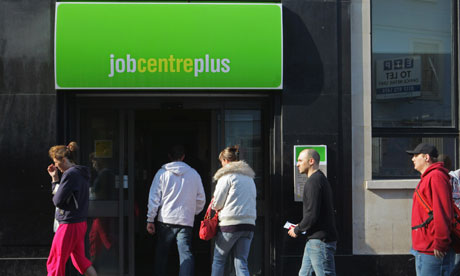Source:- Google.com.pk
Jobcentre Plus is a brand used by the UK Department for Work and Pensions for its working-age support service in the United Kingdom, its services offered directly by the Department for Work and Pensions.
From 2002 to 2011, it was the name of a government executive agency, formed by the amalgamation two agencies: the Employment Service, which operated Jobcentres, and the Benefits Agency, which ran social security offices. It reported directly to the Minister of State for Employment.
1 Role of Jobcentre Plus
2 History
3 Organisation
4 Statistics
5 Changes to the service
6 JSAPS
7 Popular culture
8 Winding-up of Jobcentre Plus
Role of Jobcentre Plus
Jobcentre Plus is an executive agency of the Department for Work and Pensions of the government of the United Kingdom. The agency provides services primarily to those attempting to find employment and to those requiring the issuing of a financial provision due to, in the first case lack of employment, of an allowance to assist with the living costs and expenditure intrinsic to the effort to achieve employment, or in all other cases the provision of social-security benefit as the result of a person without an income from employment due to illness-incapacity including drug addiction. The organisation acts from within the government's agenda for community and social welfare. Job vacancies advertised for employers within each of the public offices use a computer system called the Labour Market System (LMS). A new government website named Universal Jobmatch has recently been launched whereby jobseekers can search for employment and employers can upload and manage their own vacancies whilst searching for prospective employees.
Services are provided in the first instance via in-house job-advisors and advisors contacted via telephony. Customers are able to access vacancy information through Jobpoints (touch-screen computer terminals), via a website and a telephone service known as Jobseeker Direct. Claims may be made for working-age benefits such as Jobseeker's Allowance, Incapacity Benefit, Employment and Support Allowance or Income Support. Individuals who do make claims online are prioritised so they are processed first.
History
The forerunners of the Jobcentre Plus were the government-run Labour Exchanges, originally the vision of Winston Churchill, President of the Board of Trade and William Beveridge, who had worked for a more efficient labour system in the early years of the 20th century. This was intended to address the chaos of the labour market and the problems of casual employment. This was followed by 'Jobcentre' with its orange signage in the mid 1970s and the re-branded 'Employment Service Jobcentre' with dark blue signage from 1994 to 2002.
In 1908 Beveridge was commissioned to devise a scheme which would combine labour exchanges with a new government-funded unemployment benefit. The Labour Exchanges Bill was rushed through Parliament and passed in September 1909 and, after months of planning and recruitment of clerks, 62 Labour Exchanges were opened on February 1, 1910. The number of offices rose to 430 within four years. At the suggestion of the Prime Minister David Lloyd-George, from January 1917 the Labour Exchanges came under the new Ministry of Labour and were renamed Employment Exchanges, so as to more accurately reflect their purpose and function.
The National Insurance Act was passed in 1911 and the first payments were made at Exchanges in January 1913. Initially this covered only elected trades, such as building, engineering and shipbuilding. Weekly contributions were paid by workers, employers and the State in the form of stamps which were affixed to an Unemployment Book (later called the National Insurance card). When no work was available, benefit was payable.
The basic rules and administration regarding claims and the disallowance of benefit remain unaltered today. From 1918, payments were also made to unemployed ex-soldiers and their dependants, as well as to civilians who found themselves unemployed due to the decline of war production industries. The out-of-work donation scheme (the original "dole") was originally only a temporary measure.
As unemployment benefit was payable only for those with a contributions record, and even then for only twelve months for each claim, there remained a group on long-term low incomes, without access to benefit. That was relieved after the enactment of the National Assistance Act 1946, when payments began to be made to jobseekers on low incomes regardless of contributions.
Initially benefits were paid weekly, in cash, at the Employment Exchange. From 1973, the then Department of Employment began to open a new network of Jobcentres that advertised Jobs but did not process benefits. During this time, claimants were required to make claims and 'sign on' in separate Unemployment Benefit Offices. With the introduction of the Employment Service in the mid 1990s, the Unemployment Benefit Offices were integrated into Jobcentres. From the 1970s benefits were paid in the form of girocheque until the early 2000s when payments would be made directly to the claimants bank account.
The first fifty six Jobcentre Plus Pathfinder offices were brought into existence during October 2001.
As part of the Efficiency Savings Programme of 2004, changes were made to the structure and management of Jobcentre Plus as part of the governmental review headed by Sir Peter Gershon and Sir Michael Lyons to increase departmental efficiency amounting to £960 million, a target considered achievable in the period 2007 to 2008. This initial plan was implemented within the Jobcentre structure as the Delivering our Vision Programme. Between 2005 and 2008 directors of the board were to be reduced in number from eight to six, the number of districts from seventy to fifty, the number of management and support staff employed were reduced by 5% and, amongst other things, the number of locations specifically employed to process claims would be reduced from 650 to 77.
In the 1990s, the Jobcentre reinforced a dress code which required male staff to wear ties. The code was later held to be in breach of the Sex Discrimination Act.
Organisation
According to figures obtained by the Work and Pensions select committee during 2005-2006, the number of employees within the organisation amounted to 71,000. The amount of money released by the Department for Work and Pensions to persons in work-related benefit amounted to £100 million.
The year 2000 Makinson report written by John Makinson led to the introduction of a Team based incentive scheme, created in order to improve staff efficiency. The scheme takes as a measure of this efficiency, for the allocation of bonuses for teams meeting specific targets, (known as a performance related pay-system)[ the relative successes in each team of the factors :
of a rating by point-system based on criteria of the priority of each person to have been guided back into work (termed - Job entry)
the relative results of assessment of Customer Service
the specifics of whether the vacancy was filled at all, and if so, then the time taken for the advertised employment to be met (a measure of the satisfaction of the employer, termed - Employer Outcome)
the delivery of service professionally and with regards to the effectiveness (accuracy) of the entire organisation as a business targets (termed - Business Delivery)
a measure of the cost of levels of error by staff and customers, and of the reduction of fraud by customers.
Statistics
According to the Work and Pensions Committee the organisation caused directly or indirectly 700,000 people to return to work between the months of April 2005 and January 2006.
According to figures within the Guardian newspaper online the total number of claimants during May 2012 was 1,590,708.
Changes to the service
Private organisations are now under contract with the government to provide services to benefit claimants through initiatives such as Employment Zones and Pathways to Work. Jobsearch facilities are available to anyone via the Jobcentre Plus website, through touchscreen interactive jobpoints in local Jobcentres and over the phone via Jobseeker Direct (0845 60 60 234). The Jobcentre Plus website is the UK's most visited recruitment website with over a million visitors each week. Vacancy information is also available through the UK government's direct.gov.uk portal. As of spring 2010, the Jobcentre Plus website no longer contains job posts itself, and redirects all jobseeker enquiries to run through the Directgov jobs portal, which lists job posts sourced from the JCP network.
Jobcentre Plus also offered services to employers and employment agencies, who can register their vacancies online through the online service or by calling Employer Direct. Vacancies are available immediately through the channels above (online, phone, and interactive jobpoints).
Alongside these changes, Jobcentre Plus has also changed the way in which claims to benefits are processed. In the past, claimants contacted their local benefits office, were asked to manually complete the appropriate forms, and then booked an interview with an adviser in order to discuss work related issues (as appropriate) and submit the benefits claim for processing. The new system instead asks individuals to call a Jobcentre Plus call centre, where claim details are taken over the phone and entered directly to the computer system by the call agent. From summer 2012 new claimants with internet access are strongly encouraged to make their claim online, interview details are then sent to the claimant by text message. Customers are then asked to attend an interview at their local Jobcentre to discuss work issues with an adviser, and finalise their claim, provide relevant signatures and proof of ID and address.
In addition, the actual processing of claims to benefits is also changing, with benefits claims being processed at a smaller number of larger Benefit Centres rather than local benefit offices and jobcentres.
During 2003 the DWP commenced the use of Post Office accounts for the payment of benefits, a process fully operational at the beginning of the financial year in 2005. The accounts are licenced and the electronic benefits transfer banking engine are provided by the company JP Morgan Europe. Prior to these services the banking facility were provided by Citibank. As of 2012, the payment system for benefits is being streamlined, and all payments will now be made into bank, building society or Post Office accounts, and the use of Girocheques will be phased out by early 2013.
In 2012 the DWP announced a "trailblazer" scheme under which all new job seekers on Merseyside would be required to claim benefits online rather than in person at a Jobcentre Plus branch. This announcement was met with concern by Liverpool Wavertree MP Luciana Berger as well as chiefs at the Public and Commercial Services union and a member of Liverpool Council's cabinet. This was a partial pilot scheme for one part of the new Universal Credit benefit which it is intended will, in time, replace Income-based Jobseekers Allowance, Income-based Employment Support Allowance, Child Tax Credit, Working Tax Credit, Income Support and Housing Benefit. The changeover is scheduled to commence in October 2013 and be complete by October 2017. Incapacity Benefit is being phased out and replaced by Employment Support Allowance.
Job Center Job Application Resume Application Letter Interview Description Application Form Resume Samples Search Cover Letter Photos
Job Center Job Application Resume Application Letter Interview Description Application Form Resume Samples Search Cover Letter Photos
Job Center Job Application Resume Application Letter Interview Description Application Form Resume Samples Search Cover Letter Photos
Job Center Job Application Resume Application Letter Interview Description Application Form Resume Samples Search Cover Letter Photos
Job Center Job Application Resume Application Letter Interview Description Application Form Resume Samples Search Cover Letter Photos
Job Center Job Application Resume Application Letter Interview Description Application Form Resume Samples Search Cover Letter Photos
Job Center Job Application Resume Application Letter Interview Description Application Form Resume Samples Search Cover Letter Photos
Job Center Job Application Resume Application Letter Interview Description Application Form Resume Samples Search Cover Letter Photos
Job Center Job Application Resume Application Letter Interview Description Application Form Resume Samples Search Cover Letter Photos
Job Center Job Application Resume Application Letter Interview Description Application Form Resume Samples Search Cover Letter Photos
Job Center Job Application Resume Application Letter Interview Description Application Form Resume Samples Search Cover Letter Photos
Job Center Job Application Resume Application Letter Interview Description Application Form Resume Samples Search Cover Letter Photos
Job Center Job Application Resume Application Letter Interview Description Application Form Resume Samples Search Cover Letter Photos
Job Center Job Application Resume Application Letter Interview Description Application Form Resume Samples Search Cover Letter Photos
Job Center Job Application Resume Application Letter Interview Description Application Form Resume Samples Search Cover Letter Photos
Job Center Job Application Resume Application Letter Interview Description Application Form Resume Samples Search Cover Letter Photos
Job Center Job Application Resume Application Letter Interview Description Application Form Resume Samples Search Cover Letter Photos
















No comments:
Post a Comment